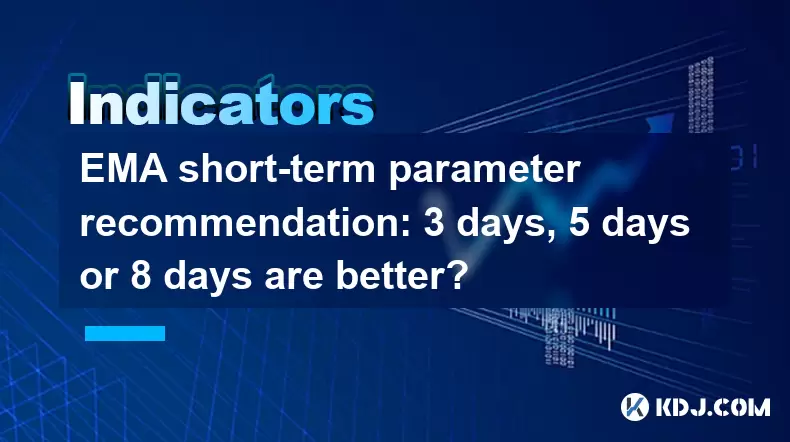-
 bitcoin
bitcoin $109523.663807 USD
-0.13% -
 ethereum
ethereum $4019.526508 USD
2.06% -
 tether
tether $1.000482 USD
0.00% -
 xrp
xrp $2.776815 USD
0.18% -
 bnb
bnb $958.942396 USD
0.12% -
 solana
solana $204.294698 USD
3.84% -
 usd-coin
usd-coin $0.999693 USD
0.00% -
 dogecoin
dogecoin $0.232115 USD
2.09% -
 tron
tron $0.338028 USD
0.84% -
 cardano
cardano $0.790920 USD
1.50% -
 hyperliquid
hyperliquid $44.871443 USD
5.60% -
 ethena-usde
ethena-usde $1.000322 USD
0.04% -
 chainlink
chainlink $21.034165 USD
2.60% -
 avalanche
avalanche $28.794831 USD
-0.54% -
 stellar
stellar $0.360466 USD
1.24%
EMA short-term parameter recommendation: 3 days, 5 days or 8 days are better?
The 3-day, 5-day, and 8-day EMAs offer varying sensitivity and reliability, making them suitable for different trading strategies and market conditions.
May 21, 2025 at 01:49 pm

Introduction to EMA
The Exponential Moving Average (EMA) is a popular technical indicator used by traders in the cryptocurrency market to assess price trends and potential entry and exit points. Unlike the Simple Moving Average (SMA), the EMA places more weight on recent prices, making it more responsive to new information. When choosing the right EMA period, traders often debate between short-term parameters such as 3 days, 5 days, and 8 days. This article will explore the advantages and disadvantages of each to help you determine which might be better suited for your trading strategy.
Understanding the 3-Day EMA
The 3-day EMA is an extremely short-term indicator that reacts quickly to price changes. This makes it particularly useful for traders who engage in scalping or day trading, where quick decision-making is crucial.
Advantages:
- High sensitivity: The 3-day EMA can help you identify rapid price movements, making it easier to catch short-term trends.
- Quick response: It can signal potential entry or exit points faster than longer-term EMAs.
Disadvantages:
- Increased noise: Because it's so sensitive, the 3-day EMA can produce false signals, leading to potential whipsaws.
- Less reliable for long-term trends: It may not be the best choice for traders looking to hold positions over longer periods.
Analyzing the 5-Day EMA
The 5-day EMA strikes a balance between responsiveness and reliability, making it a popular choice among short-term traders. It's less volatile than the 3-day EMA but still captures short-term trends effectively.
Advantages:
- Balanced sensitivity: The 5-day EMA provides a good middle ground, offering quick responses without as much noise as the 3-day EMA.
- Versatility: It's suitable for both day trading and short-term swing trading, allowing traders to adapt to different market conditions.
Disadvantages:
- Still susceptible to noise: While less noisy than the 3-day EMA, it can still produce false signals.
- Not ideal for long-term analysis: Like the 3-day EMA, it's not the best choice for long-term trend analysis.
Evaluating the 8-Day EMA
The 8-day EMA is another short-term indicator, but it's slightly less reactive than the 3-day and 5-day EMAs. This makes it a good choice for traders who want to capture short-term trends while reducing the impact of market noise.
Advantages:
- Reduced noise: The 8-day EMA is less prone to false signals compared to shorter-term EMAs.
- Suitable for short-term swing trading: It can help identify short-term trends without being overly sensitive to minor price fluctuations.
Disadvantages:
- Slower response: It may not capture very short-term movements as effectively as the 3-day or 5-day EMAs.
- May miss quick opportunities: Traders looking for the fastest entry and exit points might find the 8-day EMA too slow.
Practical Application: Using EMAs in Trading
To effectively use EMAs in your trading strategy, you'll need to understand how to set them up and interpret their signals. Here's a step-by-step guide on how to apply these short-term EMAs in your trading platform:
Setting up the EMA:
- Open your trading platform and navigate to the chart of the cryptocurrency you wish to analyze.
- Select the 'Indicators' or 'Studies' menu and choose 'EMA' from the list.
- Enter the desired period (3, 5, or 8 days) and apply it to the chart.
Interpreting EMA Signals:
- Crossovers: A common strategy is to watch for crossovers between the price and the EMA or between two different EMAs. For example, if the price crosses above the EMA, it could be a buy signal, and if it crosses below, it might be a sell signal.
- Trend Confirmation: Use the EMA to confirm the direction of the trend. If the price is consistently above the EMA, it indicates an uptrend, and if it's below, it suggests a downtrend.
- Support and Resistance: The EMA can also act as a dynamic level of support or resistance. Traders often look for bounces off the EMA as potential entry points.
Comparing the Performance of 3-Day, 5-Day, and 8-Day EMAs
To determine which short-term EMA might be better for your trading strategy, it's important to compare their performance in different market conditions. Here's a brief overview:
- Volatile Markets: In highly volatile markets, the 3-day EMA can be advantageous due to its quick response to price changes. However, it may also lead to more false signals.
- Moderately Volatile Markets: The 5-day EMA often performs well in moderately volatile markets, providing a good balance between sensitivity and reliability.
- Stable Markets: In more stable market conditions, the 8-day EMA may be more effective, as it's less likely to be affected by minor price fluctuations.
Choosing the Right EMA for Your Strategy
The choice between a 3-day, 5-day, or 8-day EMA depends on your trading style and the specific market conditions you're trading in. Here are some considerations to help you decide:
- Trading Style: If you're a scalper or day trader, the 3-day EMA might be more suitable. For short-term swing trading, the 5-day EMA could be a better fit. If you prefer a slightly longer-term approach, consider the 8-day EMA.
- Risk Tolerance: Traders with a higher risk tolerance might prefer the more sensitive 3-day EMA, while those who want to minimize false signals might opt for the 8-day EMA.
- Market Conditions: Always consider the current market environment. In highly volatile markets, a shorter EMA might be more effective, while in stable markets, a longer EMA could be more reliable.
Frequently Asked Questions
Q1: Can I use multiple EMAs simultaneously in my trading strategy?Yes, using multiple EMAs can provide a more comprehensive view of the market. For example, combining a short-term EMA like the 3-day or 5-day with a longer-term EMA like the 20-day or 50-day can help you identify both short-term and long-term trends.
Q2: How can I avoid false signals when using short-term EMAs?To minimize false signals, consider using additional indicators such as the Relative Strength Index (RSI) or the Moving Average Convergence Divergence (MACD) to confirm EMA signals. Also, pay attention to the overall market context and avoid trading during periods of low liquidity.
Q3: Are there any specific cryptocurrencies where short-term EMAs work better?Short-term EMAs can be effective for trading any cryptocurrency, but they may work particularly well for highly liquid assets like Bitcoin and Ethereum, where price movements are more frequent and pronounced. However, always consider the specific volatility and trading volume of the cryptocurrency you're analyzing.
Q4: How often should I adjust my EMA settings?It's important to periodically review and adjust your EMA settings based on changing market conditions. You might want to test different EMA periods during different market phases to see which ones perform best for your strategy. However, avoid making frequent changes, as this can lead to over-optimization and poor trading decisions.
Disclaimer:info@kdj.com
The information provided is not trading advice. kdj.com does not assume any responsibility for any investments made based on the information provided in this article. Cryptocurrencies are highly volatile and it is highly recommended that you invest with caution after thorough research!
If you believe that the content used on this website infringes your copyright, please contact us immediately (info@kdj.com) and we will delete it promptly.
- Token Costs, AI Scaling, and Computing Power: The Quest for Efficiency
- 2025-09-27 14:25:15
- Qwen3Guard: A Leap Towards Multilingual AI Safety
- 2025-09-27 14:25:15
- Rare 1p Coin Could Fetch £200,000: Are You Holding a Fortune?
- 2025-09-27 12:25:13
- MAGACOIN Finance: Buzz, Risks, and the Altcoin Stampede
- 2025-09-27 12:25:13
- Crypto Wallets & Utility Tokens: What's the Hype?
- 2025-09-27 12:30:02
- Coin Memes, Pumpfun, and ChatGPT: Navigating the Wild West of Crypto
- 2025-09-27 14:30:01
Related knowledge

What is a tower bottom candlestick pattern? Does it have a high success rate?
Sep 22,2025 at 07:18am
Tower Bottom Candlestick Pattern Explained1. The tower bottom candlestick pattern is a reversal formation that typically appears at the end of a downt...

What is a black hole pattern in the MACD indicator? Is it a cause for concern?
Sep 21,2025 at 06:54pm
Bitcoin's Role in Decentralized Finance1. Bitcoin remains the cornerstone of decentralized finance, serving as a benchmark for value and security acro...

How can I use the psychological line (PSY) to determine market sentiment?
Sep 17,2025 at 02:19pm
Understanding the Psychological Line (PSY) in Cryptocurrency TradingThe Psychological Line, commonly referred to as PSY, is a momentum oscillator used...

How can I determine if a double top pattern has officially formed?
Sep 21,2025 at 03:18am
Understanding the Structure of a Double Top Pattern1. A double top pattern consists of two distinct peaks that reach approximately the same price leve...

What is the Golden Valley pattern on the moving average? Is it better than the Silver Valley pattern?
Sep 21,2025 at 02:54pm
Understanding the Golden Valley Pattern in Moving Averages1. The Golden Valley pattern is a technical formation observed in cryptocurrency price chart...

What does a death cross of the RSI in the strong zone (above 50) mean?
Sep 17,2025 at 10:54pm
Understanding the Death Cross in RSI Context1. The term 'death cross' is traditionally associated with moving averages, where a short-term average cro...

What is a tower bottom candlestick pattern? Does it have a high success rate?
Sep 22,2025 at 07:18am
Tower Bottom Candlestick Pattern Explained1. The tower bottom candlestick pattern is a reversal formation that typically appears at the end of a downt...

What is a black hole pattern in the MACD indicator? Is it a cause for concern?
Sep 21,2025 at 06:54pm
Bitcoin's Role in Decentralized Finance1. Bitcoin remains the cornerstone of decentralized finance, serving as a benchmark for value and security acro...

How can I use the psychological line (PSY) to determine market sentiment?
Sep 17,2025 at 02:19pm
Understanding the Psychological Line (PSY) in Cryptocurrency TradingThe Psychological Line, commonly referred to as PSY, is a momentum oscillator used...

How can I determine if a double top pattern has officially formed?
Sep 21,2025 at 03:18am
Understanding the Structure of a Double Top Pattern1. A double top pattern consists of two distinct peaks that reach approximately the same price leve...

What is the Golden Valley pattern on the moving average? Is it better than the Silver Valley pattern?
Sep 21,2025 at 02:54pm
Understanding the Golden Valley Pattern in Moving Averages1. The Golden Valley pattern is a technical formation observed in cryptocurrency price chart...

What does a death cross of the RSI in the strong zone (above 50) mean?
Sep 17,2025 at 10:54pm
Understanding the Death Cross in RSI Context1. The term 'death cross' is traditionally associated with moving averages, where a short-term average cro...
See all articles










































































